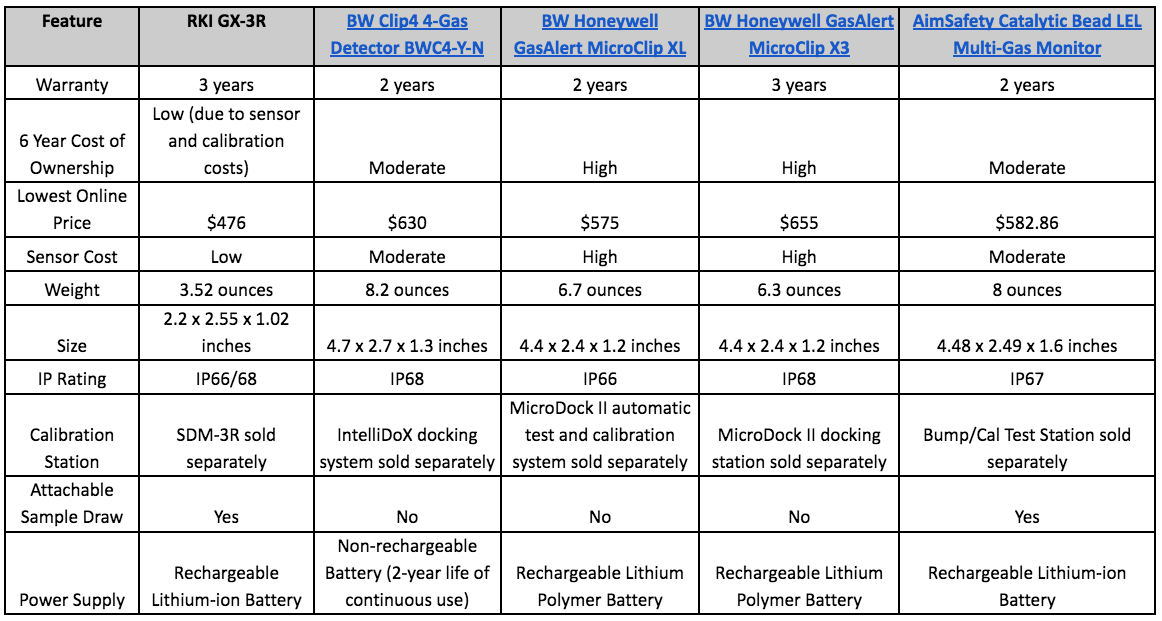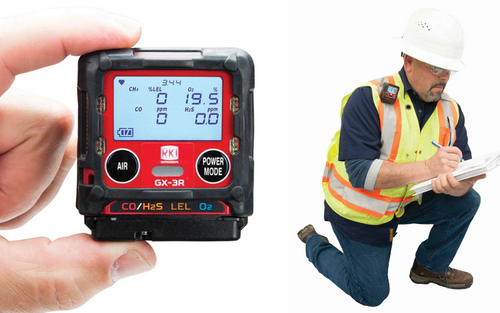Explore the RKI GX-3R: The Smallest 4-Gas Monitor | PK Safety
Four-gas monitors have become critical components of workplace safety for industries where exposure to potentially harmful gases is commonplace. With advanced sensor technologies and smart notifications, these instruments ensure users have the utmost situational awareness regardless of the application. So, how do you make them even better?
RKI Instruments' recipe puts a powerful device with all the features you can expect from an advanced gas monitor in a compact yet extremely durable package. That’s exactly what they achieved with the RKI GX-3R.
Key Features and Specifications of the RKI GX-3R Monitor
The GX-3R is the smallest 4-gas monitor in the market today. No larger than a regular tape measure (2.2” W x 2.55” H x 1.02” D) and weighing just 3.52 ounces, the GX-3R clips comfortably within the user’s breathing zone. The Occupational Safety and Health Administration (OSHA) defines this area as the 10-inch radius immediately surrounding the user’s nose and mouth (OSHA, 2023).
Despite its compact size, the GX-3R doesn’t compromise on performance, reliability, or advanced features. Here’s a closer look at what it brings to the table:
- Advanced Sensor Technology: The GX-3R simultaneously monitors and displays readings on combustible gases, oxygen (O2), carbon monoxide (CO), and hydrogen sulfide (H2S). Its LEL (Lower Explosive Limit) sensor has improved silicone resistance, while O2 detection is provided by a lead-free electrochemical sensor. Meanwhile, the H2S and CO are detected by a combination sensor, with an option to switch to a hydrogen-compensated CO sensor. These enhancements result in a more accurate instrument with a longer sensor lifespan of 3-5 years.
- Customizable Alarms: The GX-3R’s three-alarm setpoints are fully programmable, allowing users to set different alarm thresholds based on their specific safety requirements. In addition, its non-compliance indicators flash every 30 seconds when the instrument hasn’t been bump tested, calibration is due, or a gas alarm event occurred.
- Data Logging: The GX-3R’s built-in data logging system records alarm events, calibration, bump tests, and individual data points, allowing safety managers to analyze historical data and identify trends, patterns, and potential hazards. You can wirelessly pull the data into a computer using an infrared reader.
Finally, the RKI GX-3R is built to withstand harsh industrial environments, with its impact-resistant body passing drop tests of up to 23 feet. It also has an IP66/68 rating, ensuring dust and water resistance. Ingress protection (IP) ratings grade the resistance of an enclosure against the intrusion of dust or liquids.
According to the International Electrochemical Commission, “The first numeral refers to the protection against solid objects and is rated on a scale from 0 (no protection) to 6 (no ingress of dust).” Meanwhile, the second digit rates the enclosure’s protection against liquids using a scale from 0 (no protection) to 9 (high-pressure hot water from different angles) (IEC, n.d.).
Advanced Digital Readout for Enhanced Monitoring
The RKI GX-3R boasts its advanced digital readout upon startup. Pressing and holding the Power/Mode button to turn the device on automatically displays an alert when the instrument requires calibration or bump testing. This ensures the GX-3R is in optimal condition before use.
During its warmup sequence, it displays the following information:
- Date
- Battery level
- The active sensors and their full scales
- Warnings
- The set alarm thresholds for low, high, STEL (Short-Term Exposure Limit), and TWA (Time Weighted Average)
- User and Station ID
When the unit is in standard operation, the GX-3R’s large auto-lit LCD simultaneously displays LEL and O2 percentages and CO and H2S parts per million (ppm), allowing users to see all relevant information at a glance. Pressing the Power/Mode button scrolls through the display mode, which shows the following:
- Peak readings (reset every time the unit is turned off)
- Current STEL and TWA
- Option to change the target gas
- Information on the last calibration
- Alarm setpoints
- Date, time, and temperature
The GX-3R’s comprehensive digital display is complemented by visual, audible, and vibrating alarms to ensure workers are notified of potential hazards regardless of environmental conditions.
Convenience of Replaceable Batteries and Sensors
Reliability is a core component of RKI Instruments’ gas detection solutions. The GX-3R ensures workers are always aware of potential atmospheric hazards with a lithium-ion battery capable of 25 hours of operation on a three-hour charge. And while the improved sensor technologies of the GX-3R enhance their lifespan, users can easily replace sensors and filters whenever needed with nothing more than the replacement parts and a Phillips head screwdriver.
Here’s an overview of how easy it is:
- Unscrew the unit’s bottom cover to access the filter and sensor gaskets. The first thing you’ll see when you remove the cover is the hydrophobic filter. If you need to replace it, simply peel off the filter gasket.
- The LEL and dual CO-H2S filters are under the hydrophobic filter gasket. Turn the unit upside down to remove them. The filter slots are keyed, so you need to rotate them to lock them in.
- When you’re putting everything together, ensure the filters are lined up with the appropriate sensors.
Once the bottom cover is screwed back on, be sure to calibrate the replaced sensors. You can find the calibration instructions in the owner’s manual.
Comparative Analysis: RKI GX-3R Versus Other Industry Monitors
When selecting the appropriate gas monitor for your specific applications, it’s essential to consider factors such as warranty duration, cost of ownership, and ease of use. To give you a better idea of how the RKI GX-3R fares against its closest competitors, here’s a simplified comparative analysis of the different gas monitoring instruments:

In addition to being the most compact 4-gas monitoring solution, the RKI GX-3R is a versatile, powerful, and cost-effective instrument ideal for various industries and applications. Contact us today to learn more about the ideal gas detection system for your specific requirements.
FAQs: Understanding the Efficiency and Maintenance of the GX-3R
- How often should the RKI GX-3R be calibrated?
We recommend calibrating the GX-3R every three months and bump testing the instrument before each use. You can perform a bump test in User Mode’s BUMP item or by applying gas in Measuring Mode. The instrument doesn’t need to be calibrated unless it fails the User Mode bump test or doesn’t respond appropriately.
- What kind of environments is the GX-3R suitable for?
The GX-3R’s compact size and easy-to-use design make it ideally suited for a wide range of applications, including sewage treatment plants, utility manholes, tunnels, hazardous waste sites, power stations, petrochemical refineries, mines, paper mills, drilling rigs, and fire fighting stations.
References:
- Occupational Safety and Health Administration. (2023, September 14). OSHA Technical Manual (OTM) Section II: Chapter 1. Retrieved from https://www.osha.gov/otm/section-2-health-hazards/chapter-1
- International Electrotechnical Commission (n.d.). IP ratings. Retrieved from https://www.iec.ch/ip-ratings
Recent Posts
-
Understanding Respirator Replacement Filters
According to the Occupational Health and Safety Administration (OSHA), millions of workers are re …Aug 2nd 2024 -
Explore the RKI GX-3R: The Smallest 4-Gas Monitor | PK Safety
Four-gas monitors have become critical components of workplace safety for industries where exposu …Aug 1st 2024 -
August 12-18 is OSHA’s Safe + Sound Week 2024
Every August, the Occupational Safety and Health Administration (OSHA) spearheads Safe + Sound We …Aug 1st 2024





